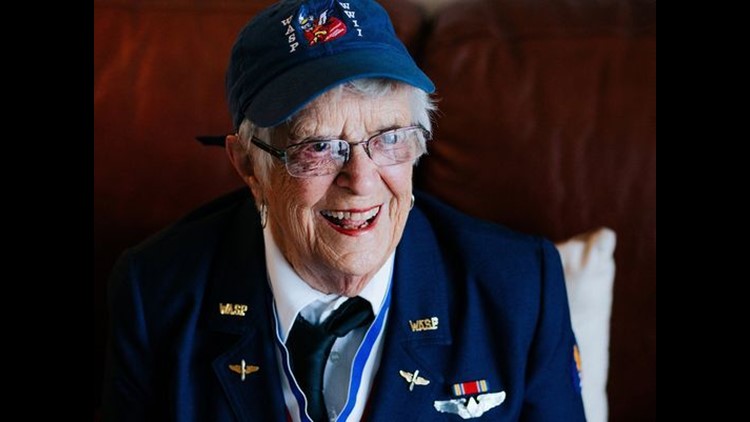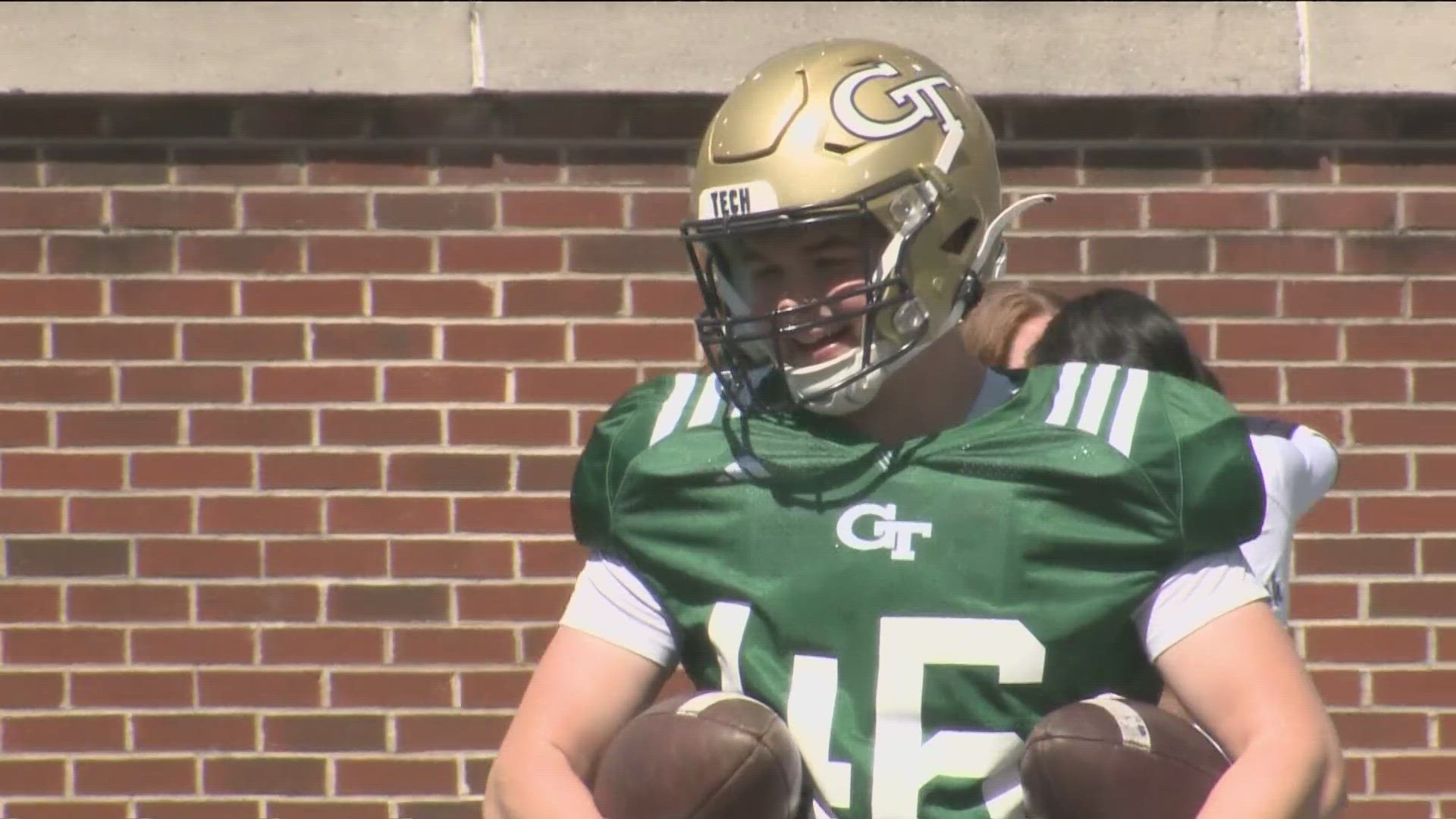GRAND RAPIDS, Mich. — This Veterans Day, Michigan's last living member of the Women Airforce Service Pilots program will proudly display a poster board of pictures from her time in the service alongside displays from other veterans of World War II who live in her senior living complex.
Jane Doyle, 96, has a Congressional Gold Medal with the words: "The first women in history to fly American Military Aircraft" etched on the outer rim.
She earned it — even if it did take 66 years. The medal is the highest honor that can be awarded to a civilian, and Doyle got it for her service during World War II for flying in the program known as WASP.
It took an Act of Congress to give the medals to Doyle and the 1,073 other WASP fly girls who boosted the war effort. The women were recruited to fly stateside for the U.S. Army Air Forces during the war, freeing up male pilots to serve in combat overseas.
According to Texas Woman's University, the repository for the history of the group, Doyle is the last living WASP in Michigan. In all, just 69 remain nationally.
She was a trailblazer unafraid to be the first girl or woman to do just about anything — practically a poster child for today's feminist mantra: nevertheless, she persisted.
"The Women's Airforce Service Pilots were groundbreaking in the same way that the iconic Rosie the Riveters were — one in flying and one in building the aircraft," said Kristen Wildes, director of the Ada Historical Society.
"When the men left to serve in the war, these remarkable women stepped in to assist in the war effort and get the jobs done. Through their dedication and service, the WASPs got a foot in the door of a future that would slowly open to women in aviation."
Doyle, who was born Mildred Jane Baessler in October 1921, was the youngest of four children. "I think I was a problem child because I was always trying something," she said.
"I don't know why my folks named me Mildred," she said. "They never called me that. They always called me Jane."
It wasn't until she enrolled in what was then Grand Rapids Junior College in 1939 that Doyle considered flying an airplane was something she could do.
"I was taking engineering drawing and I was the only girl in the class," Doyle said. "I was ordered to sit in the back in the corner and the instructor came in and was talking to the fellas about this Civilian Pilot Training Program.
"After the class, I went up and said, 'How about women? Can I get in?' And he said, 'Well, I’ll find out.' And then he told me that one woman could get in for every 10 men.
"Men had to be 5-foot-4, but women could be 5-foot-2½. So I stretched, and passed the physical and got into the program that summer."
She did 70 hours of ground school training, and went on to do 35 hours of flying at Kent County Airport at a time when much of the world was at war.
By the fall of 1940, Doyle was enrolled at the University of Michigan in Ann Arbor, and flying with the Civil Air Patrol to keep her pilot's license.
"I flew with anybody that would take me," she said.
Then, Pearl Harbor was attacked. Doyle's brother enlisted in the Navy as an officer, serving on a destroyer in the Pacific. Her sister joined the American Red Cross.
And one day, a telegram arrived from Jacqueline Cochran, the founder of a flying program that was recruiting female pilots from around the country to join the war effort.
"I got a telegram asking, 'was I interested?' ... I responded that I was interested.
And then I got a notice that said ... I had to go pass a physical at Selfridge Field," Doyle said.
She passed the tests and made her way to Texas for seven months of training at Avenger Field in the town of Sweetwater.
Altogether, Doyle and the other WASPs flew 60 million miles of operation flights from 1942-44 and piloted 78 types of aircraft, according to Kimberly Johnson, the director of special collections at Texas Woman's University.
"The WASP pilots flew every type of plane the men flew, in every type of assignment and mission except for combat," said Keith Gill, director of exhibits and museum programming at the Air Zoo in Portage, Mich.
"When the B26 Marauder bomber and the B29 Superfortress bombers were first test flown they were considered unsafe. It took WASP pilots to fly them in demonstration flights to prove that after modifications had taken place, and male pilots retrained, that the planes could be trusted and were indeed safe to fly. In fact the B26 went on to have the lowest loss rate of any USAAF bomber."
Because they weren't considered part of the military at the time — they were civilians, the WASPs had to buy their own uniforms, cover the costs of traveling to the training center, and to their assigned bases. They had to pay rent, and cover other expenses. And when a woman died on the job — as 38 of them did — her family got nothing.
"For those that were lost, whose lives were given during the war, the government didn’t pay to get them back home, for their families to lay them to rest. There was a lot of sacrifice, but they did so willingly," Johnson said.
"What they did was open so many doors."
When Nancy Parrish learned about the work her mother, Odean Bishop Parrish, and fellow WASPs did during the war, she started a website called wingsacrossamerica.orgto honor them and chronicle WASP history. Over the years, she has interviewed hundreds of women who flew for the group.
"Jane is probably one of the most fearless of the WASPs still alive," said Nancy Parrish, whose mother was better known as Deanie, and was one of the women who roomed with Doyle during training in Texas in 1943 and 1944.
"And every WASP I interviewed loved to fly, and to have something you love in service to your country was a win-win. The timing was perfect because we needed them."
But then, suddenly, America didn't need them anymore.
"These women, they were taken seriously," Johnson said. "They could do the job. And while the program did get disbanded, it wasn’t because they weren’t able or capable. It was because we were winning the war, we weren’t as needed overseas. The men were coming back, and they wanted those jobs.
"At the time, it was OK to have women flying if the men were flying in combat overseas. But it wasn’t OK if the men were back."
Doyle said the men at Freeman Field treated her well, but, she said, "there was some resentment against us women being pilots. I don't know. ... When we got the notice that we were being disbanded, I felt bad about it, but all of us just accepted it and our job was done and we went home.
"Some were teachers, and they went back to teaching. A few of them were still flying and started their own air schools and went back as instructors. There were girls from all walks of life."
When the WASP program was disbanded in December 1944, all military documentation of the women's service was sealed and classified.
"Sadly, their story was not known as the records of their program were considered classified or secret and historians knew little about their service to their country."
Doyle met her husband, Donald Doyle, a flight instructor and check pilot, at Freemont Field in Indiana in June 1944.
Two months after they met, Jane Baessler became Jane Doyle.
"They said it wouldn't last a year," Doyle said. Instead, it lasted 67 years and gave them five children, a dozen grandchildren, and 19 great-grandchildren.
Jane didn't do much flying after the WASP program was disbanded, but she would fly around to keep her hours up.
Though she had a degree in design from the University of Michigan College of Architecture, she worked at a school for visually impaired children for a few years, then took a series of jobs for Aquinas College.
She didn't talk about her days flying as a WASP in service to her country.
"I never spoke about it for many years," Doyle said.
It wasn't until the 1970s, when the first women were admitted to the Air Force pilot training program and were incorrectly heralded as the first women to fly military planes, that the public began to learn about the WASP program. Many of Doyle's fellow WASPs spoke up to set the record straight.
In 1977, President Jimmy Carter recognized their work and granted the 1,074 women who served military veteran status.
As time has passed, Doyle has found her voice.
"My daughter, she goes with me to a lot of the lectures, and she keeps saying I find out more about you all of the time, things we didn't know," Doyle said.
"You say the word WASP, you think of an insect, and it's an insect you really don't want around and you get rid of," Doyle said. "That's sort of the way it was with the WASPs, you know? They wanted to get rid of us.
"... And now, the women that are pilots they keep praising us for opening up the field for them. They call us pioneers, ... the women in different fields of aviation, even the astronauts and the gals in the military, they all say, 'If it wasn't for you, we wouldn't be doing this today.' "
Follow Kristen Jordan Shamus on Twitter: @kristenshamus



